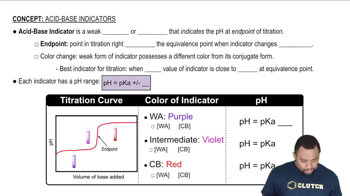Here are the essential concepts you must grasp in order to answer the question correctly.
Henderson-Hasselbalch Equation
The Henderson-Hasselbalch equation is a mathematical formula used to calculate the pH of a buffer solution. It relates the pH of the solution to the pKa of the weak acid and the ratio of the concentrations of the conjugate base to the weak acid. The equation is expressed as pH = pKa + log([A-]/[HA]), where [A-] is the concentration of the conjugate base and [HA] is the concentration of the weak acid.
Recommended video:
Henderson-Hasselbalch Equation
Buffer Solutions
Buffer solutions are mixtures that resist changes in pH when small amounts of acid or base are added. They typically consist of a weak acid and its conjugate base, or a weak base and its conjugate acid. In this case, lactic acid and sodium lactate form a buffer system that helps maintain a stable pH in the solution, which is crucial for many biochemical processes.
Recommended video:
pKa and Acid-Base Equilibrium
The pKa is a measure of the strength of an acid in solution, defined as the negative logarithm of the acid dissociation constant (Ka). It indicates the pH at which half of the acid is dissociated into its conjugate base. Understanding pKa is essential for using the Henderson-Hasselbalch equation, as it helps determine the pH of the buffer solution based on the concentrations of the acid and its conjugate base.
Recommended video:
 Verified step by step guidance
Verified step by step guidance

